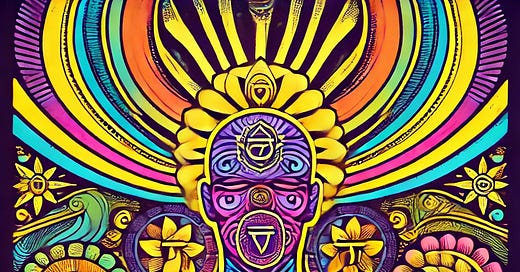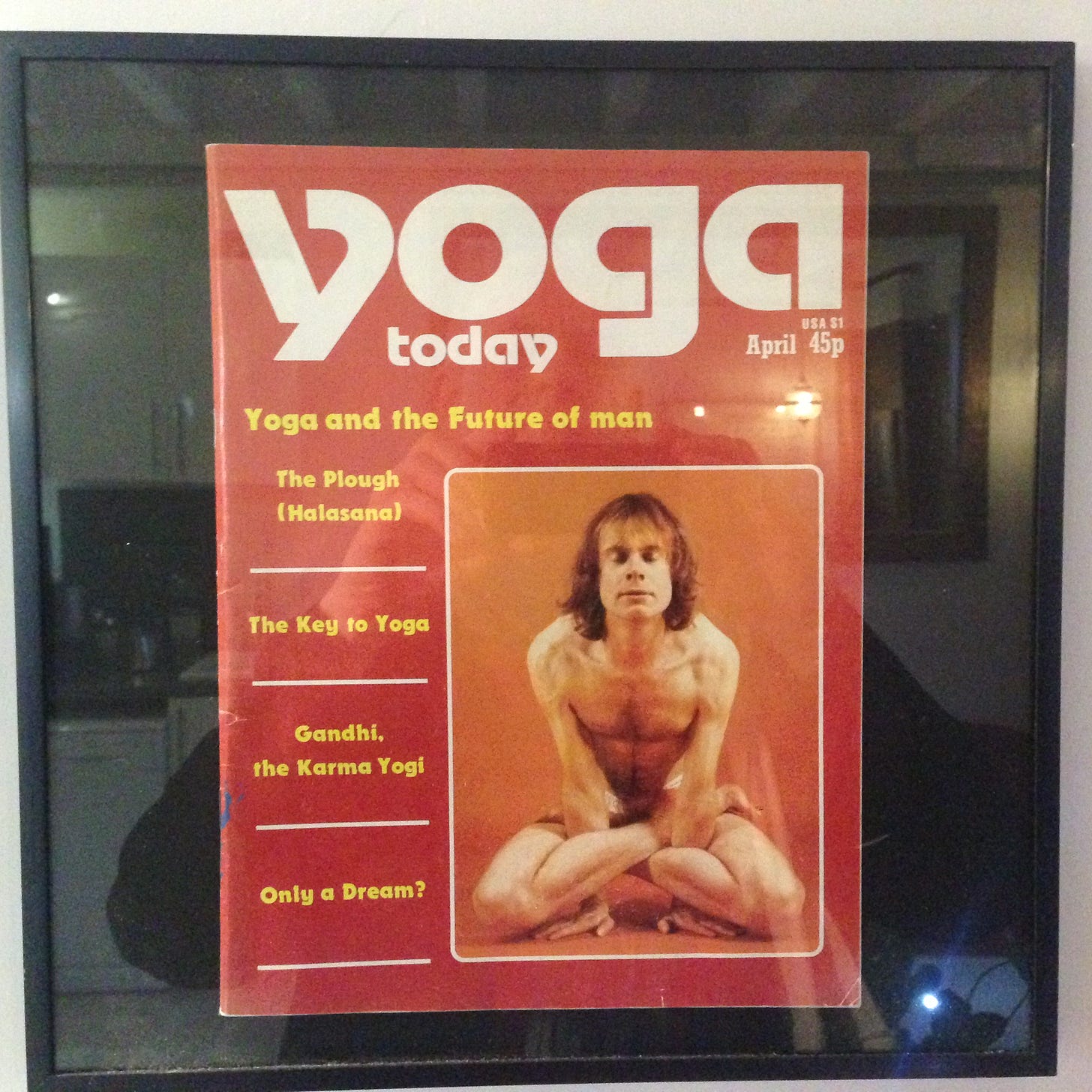Someone introduced me to a chakra meditation
Of course, I had to ask the question 'What is this exactly? And who made it up?'
A teacher of mine in another context suggested following Vivienne Crowley’s exercise for opening and closing the chakras. I’m a little bit of a chakra sceptic and tend to oscillate between viewing them as a useful construct, especially in a yogic context and colonial act of appropriation and misrepresentation if I’ve been doing a lot of EDIB training at my day job. I am, in short, very inconsistent in my approach.
Chakras aren’t a complete unknown to me but my experience of them can be summarised as hearing various yoga teachers cite them in a casual sort of way, looking up the relevant correspondences whenever they come up in a tarot text and reading about their history in a number of sources. However, I’m also a very obedient student and when my teacher tells me to try something, I try! You can skip this next bit if this is a regular or familiar part of your practice.
Vivienne Crowley (no relation to Aleister) is a bit of a triple threat - respected academic, Jungian analyst and Wiccan High Priestess. Her exercise, written as part of a series of suggestions about learning to work with energy talked about circles, spirals and snakes (I’ll get to snakes). I diligently recorded it but ended up doing something from memory instead, though using the same colours and broadly the same structure.
Imagine a glowing red sphere at the base of your spine - this is your muladhara or base chakra. Imagine drawing more and more energy into this sphere. Visualise it pulsing more and more brightly and expanding until it feels like a tank of glowing, vibrant red energy
You can draw a red current of energy moves upwards and ‘awaken’ the next sphere - the orange sacral chakra. Keep drawing on and filling that tank until the orange sphere (svadisthana) is vibrantly full.
Go back down to the base of the spine and draw up the energy towards the next sphere - a beautiful golden yellow orb found in the solar plexus (manipura). Keep the flow going, keep that tank filling up.
Follow the same visualisation up through the other spheres - the green anahata heart chakra, blue throat chakra (visuddi) and the violet Third Eye chakra - Ajna, pure mind.
Let the current of energy shoot up through the violet chakra and fountain up and out of the white crown chakra, Sahasrasa, bathing your whole body in a stream of light. Keep this cycle going for as long as needed.
Having opened your chakras and worked on any blockages (some take longer than others - Crowley recommends trying in reverse to get a build-up of energy from the crown downwards if needed) or performed some sort of ritual or meditational work, you naturally have to close them. If you open a door and leave it unattended, something undesirable might wander in. The closing meditation uses the the white flood of light from the crown to ‘draw a shade’ over each chakra in turn, covering each distinct colour in white light. Leave the red base-of-the-spine chakra and the crown chakra alone, or you’ll shut yourself off from your most vital sources.
I went back to Crowley’s text (in Wicca, 2005 edition) to check if I’d missed anything and (apart from adding the names Crowley uses) I noticed that I’d replaced circles with spheres and swapped out the kundalini related serpentine motion of the energy for distinctly Apollonian straight lines. I suspect this is because of my reasonably regular use of Tree of Life imagery for pretty much everything. It’s natural for me to think about spheres and straight lines rather than circles and snakes.
I have to say, I’m finding this exercise a valuable one, whether using circles or spheres. But, being me, I can’t just take things as they are. I have ask, what exactly is it I’m doing here and what am I doing it with?
Yogis will be familiar with the idea of pranayama, the practices of breathing control that conduct, purify and move the vital energy of the body around the subtle channels called nãdis. Some may have encountered it through the popular practice of Yoga Nidra. Influential tantric practices emerging in the tenth century taught that these channels were routed through six power centres called cakras, which translates as ‘wheels’, and that six variant forms of the goddess Kubjika and her consort were through these invested in the body of the yogi [Roots of Yoga, Translated and edited by James Mallinson and Mark Singleton, Penguin Classics 2017]. Practices involving the goddess Kundalini developed later, initially as a visualisation practice but later involving physical components as part of hatha yoga. The goddess resides at the base of the spine and through these practices rises up to the crown of the head.
I’m not going to try and summarise a history of tantric, royal, kundalini and hatha yoga here - there are a millions of better qualified individuals who devote themselves to these paths. The point I want to make is that chakras (or cakras) already had a long, twisty history of development before anyone in the west had ever heard of them.
Occultist Phil Hine, who’s looked into this history rather more deeply than most, dates their arrival in the West to the second half of the nineteenth century and talks about the ‘dominant discourse of chakras’ being that they are centres in the body relating to energy and that at the base of the spine, a mysterious Serpentine power called ‘kundalini’ sleeps, ready to be awakened and trigger psychic abilities or states of enlightenment. He goes on to point out that popular books on chakras tend to treat all source texts and teachings as a single, homogenous source, as opposed to many different sources, authorities and beliefs developed over many centuries. He catalogues a large sample, which range from as few as five chakras to as many as eleven with various numbers of “sub-chakras” putting in an appearance.
It should be said that these are all deeply considered spiritual traditions formulated by dedicated devotees focused on achieving substantive relationships or union with the divine.
Hine also points out that in Tantra tradition, chakras are places where deities are placed and worshipped. He criticises Western chakra devotees for homogenising and secularises these traditions, reserving the majority of his ire for Jung. I have to say, Hine has a point. When western chakra devotees talk about them it does tend to be rather transactional. For example, a fat paperback on our shelves [title redacted - trying not to be too mean here] talks about them in very transactional terms, mentioning the associations of deities, colours and so on and skimming through their roots in Tantra but stating definitively that chakras are a symbolic system (I suspect the gods may have other views).
The author then goes on to describe the use of the chakras in a very functional way - how to address emotional issues with the Heart chakra, for example, or explaining how the Throat Chakra is associated with sound and how “the vibrations of our voices cause its [sound’s] molecular structure to change and rearrange themselves into patterns of harmony”. Sound, by the way, does not have molecules but let’s leave that rabbit hole for another time.
As an aside, I know that the idea of the loss of emphasis on the spiritual or religious aspect of yoga is a criticism often levelled at yoga in general. I’ll just note that 1) there are a lot of good yoga teachers who are attentive to the spiritual aspects of what they do and sensitively reference them, even if its in a syncretic or simplified form. 2) yoga is also an appallingly commoditised area - but isn’t that true of almost everything to do with spirituality in our benighted times? 3) the Theosophists who first brought yoga to the West focused on its spiritual or esoteric potential, not its potential for making you look good in tight clothes and, 4) Hindu nationalism is weaponising yoga in a distinctly un-yogic way. Religion is wonderfully different everywhere but nationalists are always the same.
So where does this leave us?
It leaves us with the obligation to ask questions about our practice and what it’s doing for us, to answer them as honestly as we can and to work with the consequences. Clearly the chakra practice I’ve been introduced to has only the faintest of connections with my long-standing yoga practice. But, as with yoga, systematically calming, focusing and working with the mind in a way that grounds the body in its environment and centres one in the present moment is an incredibly worthwhile process in its own right. It’s also worth exploring how connections with other systems holding personal meaning might be made. There are experiments (and many different correspondence systems with very grand names out there) to be made with Qabalah, astrological and elemental assignments, the Golden Dawn colour systems, even the visualisation of different divine forms from whatever pantheon works for you. As ever, mileage will vary
.Meanwhile, I want to return to the image of the red kundalini energy rising from the base of the spine and the white universal energy, the combined colours of the rainbow, flooding down from the Crown. It reminds me of two of the most beautiful cards in the tarot - The Star and Temperance. Both offer images of balancing in both cosmic and practical ways. When I work through both halves of this meditation, I return particularly to the Star and the image of a constant cycle of energy flowing and renewing, continually reminding me that I’m a very small but not insignificant part of something very large, connected and beautiful. Works for me.







I agree about the Star and Temperance, and used Ushas, the sister of the goddess of the Dawn as the image for Temperance.... the ability and Power to Adapt. I lived through that ability as a widow and was not surprised that it followed the Death or Changes card. It is a very important card in the Tarot. She helped me a lot. I shall explore her here one day, as I feel it is not only the soul left behind adapting but the soul that has gone on adapting. Wondered if you had any ideas on that?
Gabriel, I began in early days with playing cards and collected Jokers people chucked aside, usually if they gamed or gambled, then discovered Tarot through the Jokers, and after a startling vision of a gold and silver Tree at 8 years old, while desperately appealing to a God to show him or her self, then discovered anything to do with trees, including growing them, finding Ogham, Qabalah, Yggdrasil, many different systems throughout the world and eventually Yoga, and Light, all different types of meditation and Chakras etc; but the open-eyed system of meditation was amazing. I still held onto the system of Tarot, amalgamating East, West, Middle, North, South, Space.... Mastering one, all the others fall into place. Not enough time in a lifetime to explore every single one of them. Like you, I have studied and I enjoy meeting others who also have studied. Sharing is a way of furthering and exploring Knowledge and it is exciting and fun discovering others who follow paths. I feel it is all one anyway. Thank you for your insightful writings.***